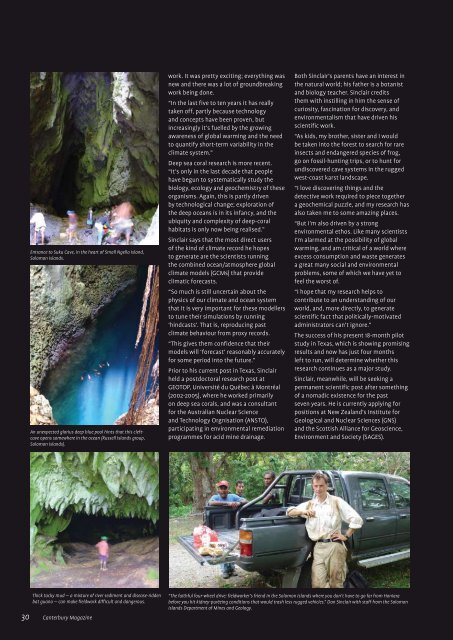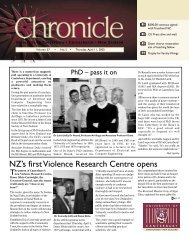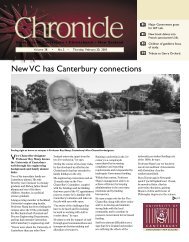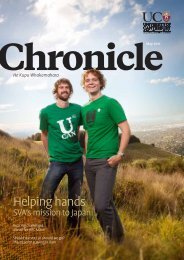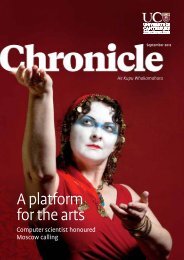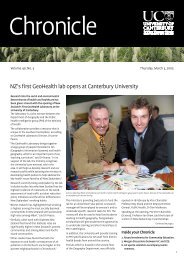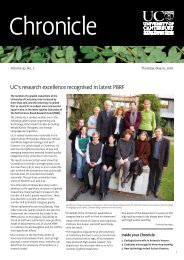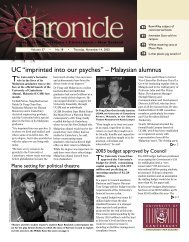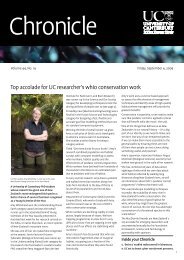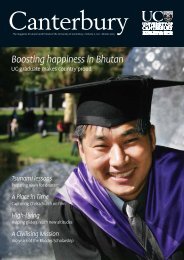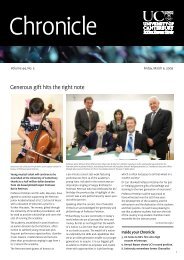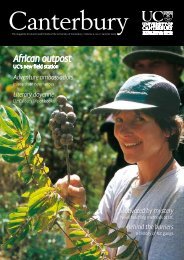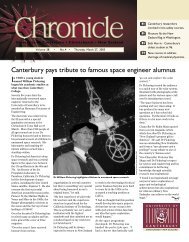Entrance to Suku Cave, in the heart of Small Ngella Isl<strong>and</strong>,Solomon Isl<strong>and</strong>s.An unexpected glorius deep blue pool hints that this cleftcaveopens somewhere in the ocean (Russell Isl<strong>and</strong>s group,Solomon Isl<strong>and</strong>s).work. It was pretty exciting; everything wasnew <strong>and</strong> there was a lot of groundbreakingwork being done.“In the last five to ten years it has reallytaken off, partly because technology<strong>and</strong> concepts have been proven, butincreasingly it’s fuelled by the growingawareness of global warming <strong>and</strong> the needto quantify short-term variability in theclimate system.”Deep sea coral research is more recent.“It’s only in the last decade that peoplehave begun to systematically study thebiology, ecology <strong>and</strong> geochemistry of theseorganisms. Again, this is partly drivenby technological change; exploration ofthe deep oceans is in its infancy, <strong>and</strong> theubiquity <strong>and</strong> complexity of deep-coralhabitats is only now being realised.”Sinclair says that the most direct usersof the kind of climate record he hopesto generate are the scientists runningthe combined ocean/atmosphere globalclimate models (GCMs) that provideclimatic forecasts.“So much is still uncertain about thephysics of our climate <strong>and</strong> ocean systemthat it is very important for these modellersto tune their simulations by running‘hindcasts’. That is, reproducing pastclimate behaviour from proxy records.“This gives them confidence that theirmodels will ‘forecast’ reasonably accuratelyfor some period into the future.”Prior to his current post in Texas, Sinclairheld a postdoctoral research post atGEOTOP, Université du Québec à Montréal(2002-2005), where he worked primarilyon deep sea corals, <strong>and</strong> was a consultantfor the Australian Nuclear Science<strong>and</strong> Technology Orgnisation (ANSTO),participating in environmental remediationprogrammes for acid mine drainage.Both Sinclair’s parents have an interest inthe natural world; his father is a botanist<strong>and</strong> biology teacher. Sinclair creditsthem with instilling in him the sense ofcuriosity, fascination for discovery, <strong>and</strong>environmentalism that have driven hisscientific work.“As kids, my brother, sister <strong>and</strong> I wouldbe taken into the forest to search for rareinsects <strong>and</strong> endangered species of frog,go on fossil-hunting trips, or to hunt forundiscovered cave systems in the ruggedwest-coast karst l<strong>and</strong>scape.“I love discovering things <strong>and</strong> thedetective work required to piece togethera geochemical puzzle, <strong>and</strong> my research hasalso taken me to some amazing places.“But I’m also driven by a strongenvironmental ethos. Like many scientistsI’m alarmed at the possibility of globalwarming, <strong>and</strong> am critical of a world whereexcess consumption <strong>and</strong> waste generatesa great many social <strong>and</strong> environmentalproblems, some of which we have yet tofeel the worst of.“I hope that my research helps tocontribute to an underst<strong>and</strong>ing of ourworld, <strong>and</strong>, more directly, to generatescientific fact that politically-motivatedadministrators can’t ignore.”The success of his present 18-month pilotstudy in Texas, which is showing promisingresults <strong>and</strong> now has just four monthsleft to run, will determine whether thisresearch continues as a major study.Sinclair, meanwhile, will be seeking apermanent scientific post after somethingof a nomadic existence for the pastseven years. He is currently applying forpositions at New Zeal<strong>and</strong>’s Institute forGeological <strong>and</strong> Nuclear Sciences (GNS)<strong>and</strong> the Scottish Alliance for Geoscience,Environment <strong>and</strong> Society (SAGES).Thick tacky mud — a mixture of river sediment <strong>and</strong> disease-riddenbat guano — can make fieldwork difficult <strong>and</strong> dangerous.30 Canterbury Magazine“The faithful four-wheel drive: fieldworker’s friend in the Solomon Isl<strong>and</strong>s where you don’t have to go far from Honiarabefore you hit kidney-puréeing conditions that would trash less rugged vehicles.” Dan Sinclair with staff from the SolomonIsl<strong>and</strong>s <strong>Department</strong> of Mines <strong>and</strong> Geology.
Insider politicsBy Maria De CortSay “field trips” <strong>and</strong> images of bush shirt-cladbiologists or geographers hiking through tussocks aremore likely to spring to mind than aspiring politicalscientists in plush, pressed business suits ascending thesteps of Parliament.But there is a new breed of field trippers emergingfrom the University of Canterbury’s College of Arts.In June this year, Dr Bronwyn Hayward <strong>and</strong> DrTherese Arseneau (Political Science <strong>and</strong> Communication)led a group of 14 political science honours <strong>and</strong> graduatestudents on the second annual parliamentary field tripto Wellington.The students experienced first-h<strong>and</strong> the cut <strong>and</strong> thrustof daily politics in the capital. Over the course of two-<strong>and</strong>a-halfdays the students got the chance to discuss issueswith political leaders, public servants <strong>and</strong> policy analysts<strong>and</strong> receive a privileged insight into what goes on “behindthe scenes” in our nation’s corridors of power.Hayward said field trips were a key learningopportunity in arts.“The chance for students to compare what they havelearnt in a classroom with real world observation isinvaluable. We are very grateful for the way so manypolitical leaders <strong>and</strong> leaders in the community, media,business <strong>and</strong> the public service, together with UCgraduates, are willing to give their time <strong>and</strong> experienceto help mentor <strong>and</strong> inspire these students.”The intensive programme with back-to-back meetingsfrom the crack of dawn until long past dusk included afew significant political coups. The students were ableto conduct a group interview with National MPs BillEnglish, Katherine Rich <strong>and</strong> John Key on the role ofopposition parties <strong>and</strong> conduct one of the first interviewswith the new Green Party co-leader partnership of JeanetteFitzsimons <strong>and</strong> Russel Norman.One highlight of the programme was an eveningreception for 40 past <strong>and</strong> present students themed, “WhatI wish someone had told me before I graduated”.The students’ interaction with graduates now working<strong>and</strong> researching in Wellington was a great opportunity fornetworking <strong>and</strong> mentoring to take place, said Hayward.Vanessa Roberts, an honours student from the class of2003, who graduated in April this year with her Masterof Arts in political science, helped organise the eveningfunction.Roberts, who currently works for the Ministry ofHealth as a policy analyst on the National Ethics AdvisoryCommittee, said the informal mentoring session was agolden opportunity for the current students to get aninsight into “the pitfalls <strong>and</strong> highlights” of job-hunting.“I would have loved to have had this sort of opportunitywhen I was nearing the end of my postgrad study. It canbe difficult for students outside of Wellington to developa real feel for career opportunities here, especially inthe public service. It is difficult to know who you arecompeting against, what policy analyst <strong>and</strong> other rolesinvolve <strong>and</strong> if you are offered a job, whether to take it.“It is a valuable opportunity for current students to askquestions that might not be appropriate to ask lecturersor even the best careers advisers. For example, questionsabout the workplace culture in different organisations,realistic starting salaries, <strong>and</strong> how to cope with movingcities <strong>and</strong> leaving friends behind.”At a big picture level the field trip was about fosteringleadership, Arseneau said.“We recognise these students are future leaders <strong>and</strong> weare really trying to nurture them as such. It is importantto us to make sure they are engaged in the world aroundthem, particularly the political world. We want to instil inthem a sense of excitement about politics as well as a senseof their responsibility to give back to this country that ishelping to educate them.”Arseneau said this year’s students had impressedeveryone they came in contact with <strong>and</strong> were “trulywonderful ambassadors for Canterbury”.Honours student Ara Tai Rākena said a highlight forhim had been realising what an incredible democracy NewZeal<strong>and</strong>ers lived in, that allowed such unfettered access tothose in power.“Everyone we talked to was surprisingly open <strong>and</strong> it wasparticularly interesting for me to discover how people withvastly different, <strong>and</strong> often directly opposing, ideologicalviews actually enjoyed professional <strong>and</strong> productiveworking relationships with each other.”Classmate Nicky Wilson-Kelly said it was a privilege totake part in the voluntary field trip.“Despite having studied New Zeal<strong>and</strong> politics forquite a few years now, nothing could have prepared mefor the sheer delight at being able to translate some of myintellectual underst<strong>and</strong>ing of how parliament functionsinto real interactions with the political machine,” she said.“The trip definitely reinvigorated my appetite forpolitics.”Summer 2006 31


